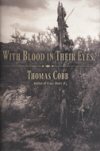With Blood in Their Eyes
In the John Ford’s 1962 classic Western, The Man Who Shot Liberty Valance, there’s a line or two that ring particularly true to writing about the West. After learning the truth about the shootout and the story behind outlaw Liberty Valance’s death, the newspaperman tells James Stewart’s character, “This is the West, sir. When the legend becomes fact, print the legend.”
In the John Ford’s 1962 classic Western, The Man Who Shot Liberty Valance, there’s a line or two that ring particularly true to writing about the West. After learning the truth about the shootout and the story behind outlaw Liberty Valance’s death, the newspaperman tells James Stewart’s character, “This is the West, sir. When the legend becomes fact, print the legend.”
Arizona’s history is filled with stories that would seem to be nothing more than these historical Western caricatures—gunfights, sheriff posses, treks through unforgiving desert terrain in frantic attempts to reach Mexico, and individuals fighting for what they see as freedom against a federal government. These episodes—these types—have become ingrained, perhaps, in the identity of Arizona over the past hundred years of statehood and, perhaps, even celebrated as a means of that identity. In writing about southern Arizona and its history, it would be easy, simple, and perhaps in some ways correct, to write to those tropes—to “print that legend.” However, With Blood in Their Eyes, author Thomas Cobb successfully plays with the space between history and legend deeply rooted in southern Arizona, and we’re left with a cast of characters to try and make sense of.
In his historical nonfiction novel (as it is termed), Cobb takes his readers through the 1918 story of four lawmen from Graham County, Arizona, who came to arrest John and Tom Power for draft evasion and died in a subsequent gunfight between the Power family and the Graham County sheriff’s posse. The gunfight and following month-long manhunt for the Power brothers through southern Arizona as the brothers fled to Mexico are the real basis for the Power story—legend?—and their incarceration, trial, and eventual parole are simply a two-paragraph epilogue at the end of the book.
With Blood in Their Eyes begins dramatically. “Prologue: February 10, 1918. John Power woke to the sound of bells and horses’ hooves. He rolled out of bed, not quite sure what was going on, just that it wasn’t right.” Right away, this is a story of conflict, tension, and complex context. Right away, you realize that this is a story that is going to have as many layers and complex strata as the geology and the landscape of the rugged and inhospitable Galiuro mountains to Cochise Stronghold to the ever-elusive Mexican border. (As a side note, one of my favorite descriptions in the book was John Power’s attempt to rock scramble over the gargantuan granite boulders at Cochise Stronghold. As an avid rock climber who has spent time bushwhacking to find hiking trails to rock routes in Cochise Stronghold, there was an unmistakable air of authenticity that rang all too true to Cobb’s description of the desperation and frustration of Power’s frantic boulder scrambling.)
With its larger-than-life stereotypes of the American West, it would be easy to write a larger-than-life account of the Power brothers’ story. In other words, it would be easy to really play to an audience’s expectation about characterizations, themes, and for Cobb to tell the story in a predictable way. But he goes beyond a simple recounting of events or a trudge through academic archives—Cobb lets the backstory of the characters and their complexities, their motivations, and their contexts be told through flashbacks as John and Tom Power, along with the hired man Tom Sisson, make their way to Mexico. The story thus unfolds almost cinematically—the drama of the events is heightened as the telling of the story holds the reader’s anticipation.
Cobb’s use of this type of storytelling mechanics is a subtle nod to the type of practically cinematic episode that he is relating. The story, in this case in conjunction with the backstories, reinforces the actually telling. There is a fantastic symmetry to the craft and the story that allows Cobb to explore themes within With Blood in Their Eyes—themes like loyalty, identity, camaraderie, and culture that would be difficult without this type of storytelling mechanics. By the end of the book, you’re not sure whether you like John and Tom Power as characters—you’re not sure whether you’re looking at the Liberty Valance outlaw or the John Wayne tragic hero. It would have been easy for Cobb to spin a historical non-fiction novel that held them up and immortalized them as folk heroes defying the “federal man” or the “system,” and it would have been just as easy to write them as fugitives that did not appreciate or understand the changing nature of Arizona’s socio-political landscape as the law worked to validate its statehood. The real genius in Cobb’s writing is that you’re left with characters that you don’t know if you like—but you’re compelled to keep reading to see how their story unfolds.
With Blood in Their Eyes is a fantastic read for a historical nonfiction novel. The complexity of the story and its surrounding themes is belied by the seeming simplicity of the characters of John and Tom Power and, to a somewhat lesser extent, the character of Tom Sisson. What is really apparent, however, is that Cobb is deeply ingrained in the complexity of Arizona and the stories and people that gave frontier Arizona its character.





